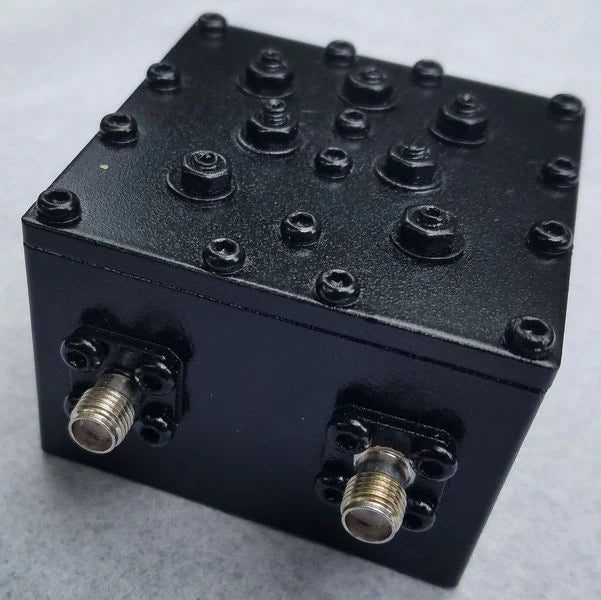Airplanes.Live Aircraft ADS-B tracking
Lothar's ADS-B Cavity Filter 1090 Mhz
Lothar's ADS-B Cavity Filter 1090 Mhz
Couldn't load pickup availability
A premium Cavity filter that provides low loss filtering of 1090 MHz ADS-B signals between an antenna and an SDR.
Most hobby grade RTL chip based TV tuner SDRs made for ADS-B 1090 MHz reception have Surface Acoustic Wave (SAW) filters for cost reasons. These chips are pennies each on SMD tape reels. The loss through these SAW filters vary between 3 dB and almost 6 dB according to the actual SAW chip manufacturers data (Taisaw and the Chinese copies), but do not include the additional losses that the companies that package them into the products you buy in the specifications, including connector losses. Packaging matters. Poor PCB strip-line design degrades SAW performance often by almost 2 dB and the lack of a grounded metal shell in effect makes everything after the filter an antenna for unwanted signals. The correct filter selection is mandatory in high RF field environments including Ham radio club sites, broadcast TV and FM transmitters and close by mobile phone towers.
In high RF environments effective RF filtering is necessary to prevent “receiver de-sensitization” from intermodulation products (which appear as noise at the demodulator input) at the first stage of RF amplification, be it in any LNA or in the SDR front end itself.
The choices for stand-alone 1090 MHz filters that should be used with higher grade un-filtered SDRs include lumped constant (passive capacitor and inductor cascades) and cavity filters. Both have lower insertion losses than SAW filters, but with different advantages and dis-advantages. Cavity filters are inherently DC grounded making system grounding easier and management of static and nearby lightning spikes less of an issue. LC filters have slightly lower loss (only .5 dB) than SAW filters but cannot approach cavity filter performance and are not inherently DC grounded. LC filters like the Flight Aware “blue tube” have the cost advantage over cavity filters at roughly a third of the cost of the least expensive cavity filters, however still have insertion losses of up to 2 dB more than cavity filters.
Improved ADS-B decoding from using a high performance 1090 MHz filter improves both overall reception range and better decoding of low level distant signals. Improved decoding of near the noise level signals is a function of the overall lower receiver system noise figure (NF) and the absence of overload intermodulation products (which are seen as lower noise) at the demodulator input. Increased range is a function of lower overall system attenuation in the receive chain which allows the typical amplifiers to operate in a liner region, and allows the actual demodulator gain to be lower as well. In other words, the dynamic range between the weakest and strongest signals that can be decoded correctly becomes much wider.
Specifications
| Manufacturer | Lothar of The Hill People |
| Filter Type | 4 Pole Iris Coupled Cavity Resonator |
| Passband | 1087 - 1093 MHz |
| Bandwidth @ -3dB | 12 MHz |
| Insertion Loss | Less than 1.0dB, 0.09 typical at 1090 MHz |
| Passband Ripple | Less than 0.5dB max within passband |
| Return Loss | Greater than 20 dB |
| Rejection | Greater than 80 dB @ 921-960 MHz |
| Power Rating | 30W (CW) |
| Operating Temperature | -20 to +55 C |
| Connectors | SMA-K, Females, -50 Ohms |
| Dimensions | 54 x 54 x 43 mm (2.13 x 2.13 x 1.79 ") |
| Paint Color | Black Satin |
Testimonials
"I received the filter yesterday. I swapped it out with the FA Blue tube filter and noticed an immediate difference. The gain of around 1.1 to 1.5db seems to have made an incredible difference in weak signal territory. Yesterday after I restarted the system with the new filter attached, by the time I got downstairs to look at my monitor, the number of planes had jumped from 138 when I went upstairs, to 186 after the swap. This morning, I have tracked more than 200 planes this morning which is more than ever. I have also been receiving occasional beacons from aircraft on the ground 15 miles away at Charlotte airport which is also a first for my location." - John
Share










